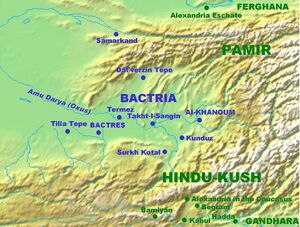Termez
| Author:Laxman Burdak, IFS (Retd.) |

Termez is a small city in the southernmost part of Uzbekistan near the Hairatan border crossing of Afghanistan. It is the hottest point of Uzbekistan.
Variants of name
Etymology
The modern name of the city came through the Sogdian Language Tarmiδ dating back to an ancient Iranian language tara-maiθa , which means "a place of transition" (tara-crossing, crossing; maiθa-place). In ancient times there was an important crossing on the Amu Darya river.
Some link the name of the city to Greek thermos "hot", tracing its name back to Alexander the Great.[1] Others suggest that it came from Sanskrit taramato , meaning "on the river bank".[2]
History
The date of the founding of the city of Old Termez, located a few kilometers east of the modern city, is not known. In April 2002 there was a celebration of the 2,500th anniversary of the city of Termez.[3]
The city was known to Achaemenids in the 6th century BC.
In 329 BC Alexander the Great conquered Termez.
Later Demetrius, the founder of Greco-Bactrian kingdom named it Demetris.
As part of the Kushan Empire (1st to 3rd century BC) The city was called Ta-li-mi (in the Chinese Tu-mi, Tami. During this period, the city became an important center of Buddhism.
In the 5th and 6th centuries the city was ruled by Hephthalites and Sassanids.
In the 7th century the city was ruled by the native Termez shah dynasty. It was a vassal of Gokturks.
In 705 the city was captured by the Arabs and it became one of the centres of Islam during the Abbadids and Samanids Empire.
From the 9th to the 12th centuries Termez was a big city and a cultural centre and was popular for shopping and crafts. At this time the length of the fortifications of the city was 10 miles long with nine gates. During this period Termez was a part of the Ghaznavids, Seljuk and Karakhanids. In 1206 the town became part of the state Khorezmshahs.
In 1220 after a two-day siege, the city was destroyed by the troops of Genghis Khan.
In the second half of the 13th century Termez was restored to the east, on the right bank of Surxondaryo River, as part of the Timurid empire, then Shaybanids. By the second half of the 18th century the city was abandoned. The only inhabited villages were Salavat and Pattakesar (Pattagissar) in the vicinity of the ancient city.
Visit by Xuanzang in 630 AD
Xuanzang Continuing southward, reached the Amu Darya and Termez, where he encountered a community of more than a thousand Buddhist monks.
Further east he passed through Kunduz, where he stayed for some time to witness the funeral rites of Prince Tardu, who had been poisoned. Here he met the monk Dharmasimha, and on the advice of the late Tardu made the trip westward to Balkh (modern Afghanistan), to see the Buddhist sites and relics, especially the Nava Vihara, which he described as the westernmost vihara in the world. Here Xuanzang also found over 3000 non-Mahayana monks, including Prajnakara,[4] a monk with whom Xuanzang studied early Buddhist scriptures. He acquired the important text of the Mahāvibhāṣa here, which he later translated into Chinese.
References
- ↑ E. M. Pospelov, Geograficheskie nazvaniya mira (Moscow, 1998), p. 415: "here in fact is found the hottest place in Central Asia (in June 1914 a temperature of 49.5 C was recorded in Termez."
- ↑ Sh. Kamaliddinov, Istoricheskaya geografiya Sogda i Toharistana.
- ↑ Sh. Kamaliddinov, Istoricheskaya geografiya Sogda i Toharistana.
- ↑ http://ccbs.ntu.edu.tw/FULLTEXT/JR-AN/an160809.htm

